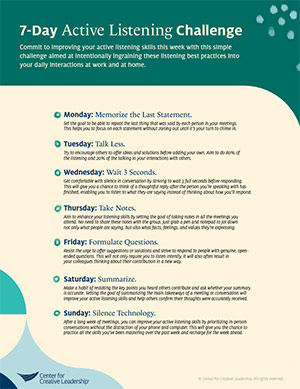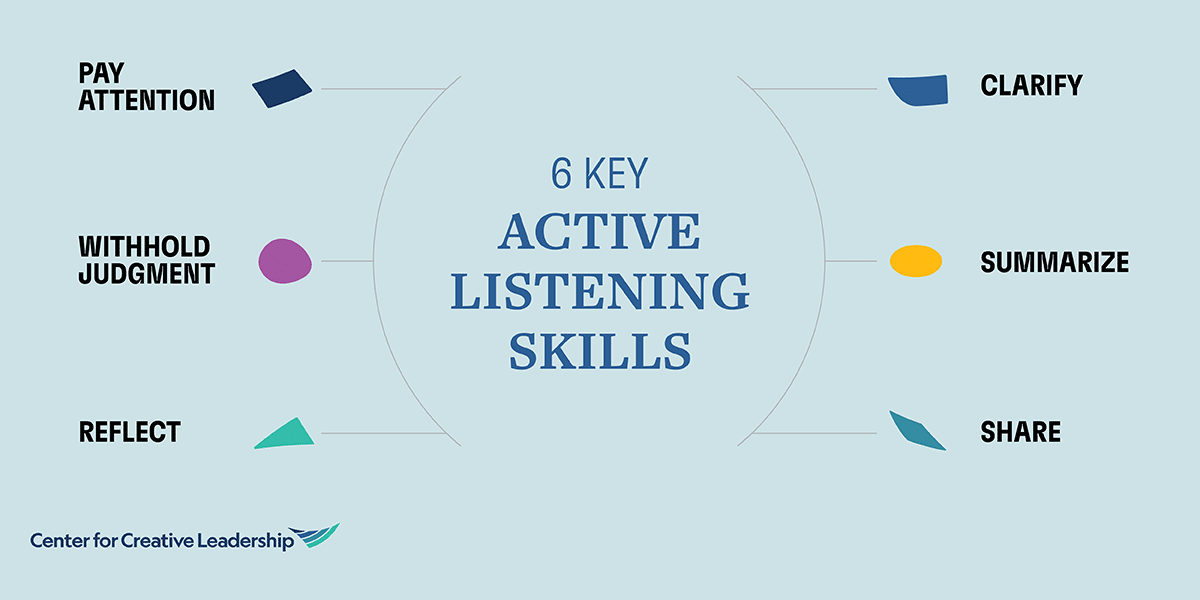How to Use Active Listening Skills to Coach Others
Active listening requires you to listen attentively to a speaker, understand what they’re saying, respond and reflect on what’s being said, and retain the information for later. This keeps both the listener and speaker actively engaged in the conversation.
Active listening and reflecting, responding, and giving feedback aren’t always easy. Here are some helpful active listening tips for managers:
- Pay close attention to the speaker’s behavior and body language to gain a better understanding of their message.
- Signal that you’re following along with visual cues like nodding and eye contact; ask clarifying questions to ensure your understanding.
- Avoid potential interruptions — from technology (e.g., phone or email notifications) and from humans (e.g., knocks on your door).
- Keep an open mind. Rather than evaluating the message and offering an opinion, simply make the speaker feel heard and validated.
- Confirm you’ve understood what the speaker has said by verifying your understanding.
- Be an attentive listener and have your toolkit of active listening techniques at the ready for whenever coaching conversations occur.
At CCL, we help leaders go beyond basic active listening skills so that they’re better equipped to truly listen to understand others — including the facts, feelings, and values that may be hidden behind the words actually being shared. At the organizational level, training people how to listen more effectively helps provide role models for the next generation of leaders and builds a workplace culture of truth and courage.
6 Active Listening Techniques
The Active Listening Skillset
Enhancing your active listening skillset involves more than just hearing someone speak. When you’re putting active listening skills to practice, you should be using these 6 techniques:
1. Pay attention.
One goal of active listening and being an effective listener is to set a comfortable tone that gives the speaker an opportunity to think and talk. Allow “wait time” before responding. Don’t cut the person off, finish their sentences, or start formulating your answer before they’ve finished. Pay attention to your body language as well as your frame of mind when engaging in active listening. Be focused on the moment, make eye contact, and operate from a place of respect as the listener.
2. Withhold judgment.
Active listening requires an open mind. As a listener and a leader, be open to new ideas, new perspectives, and new possibilities when practicing active listening. Even when good listeners have strong views, they suspend judgment, hold any criticisms, and avoid interruptions like arguing or selling their point right away. This can be easier if you maintain an open body posture. For example, having your arms resting on the side, rather than crossed across the chest, can signal a greater degree of openness.
3. Reflect and validate.
When you’re the listener, don’t assume that you understand correctly — or that the speaker knows you’ve heard them. Mirror their emotions by periodically paraphrasing key points. Reflecting is an active listening technique that indicates that you and your counterpart are on the same page.
For example, the speaker might tell you, “Emma is so loyal and supportive of her people — they’d walk through fire for her. But no matter how much I push, her team keeps missing deadlines.”
To paraphrase, you could say, “So Emma’s people skills are great, but accountability is a problem.”
If you hear, “I don’t know what else to do!” or “I’m tired of bailing the team out at the last minute,” try helping the other person label their feelings: “Sounds like you’re feeling pretty frustrated and stuck.” This can be a way to make them feel validated.
4. Clarify.
Ask questions about any issue that’s ambiguous or unclear. As the listener, if you have doubt or confusion about what the other person has said, say something like, “Let me see if I’m understanding. Are you talking about …?” or “Wait a minute. I didn’t follow you.” Asking for clarification shows you are paying attention.
Open-ended, clarifying, and probing questions are important active listening tools that encourage the speaker to do the work of self-reflection and problem solving, rather than justifying or defending a position, or trying to guess the “right answer.”
Examples include: “What do you think about …?” or “Tell me about …?” and “Will you further explain / describe …?”
When engaging in active listening, the emphasis is on asking, rather than telling. It assumes the other person has valuable input, and maintains a spirit of collaboration.
You might say: “What are some of the specific things you’ve tried?” or “Have you asked the team what their main concerns are?” or “Does Emma agree that there are performance problems?” and “What’s going on? Is there any other information that might be helpful to find out?”
5. Summarize.
Restating key themes as the conversation proceeds confirms and solidifies your grasp of the other person’s point of view. It also helps both parties to be clear on mutual responsibilities and next steps. Briefly summarize what you’ve understood while practicing active listening, and ask the other person to do the same.
Giving a brief restatement of core themes raised by the speaker might sound like: “Let me summarize to check my understanding. Emma was promoted to manager, and her team loves her. But you don’t believe she holds them accountable, so mistakes are accepted and keep happening. You’ve tried everything you can think of, and there’s no apparent impact. Did I get that right?”
Restating key themes helps with understanding and accountability.
6. Share.
Active listening is first about understanding the other person, then about being understood as the listener. As you gain a clearer understanding of the other person’s perspective, you can begin to introduce your own ideas, feelings, and suggestions. People are more receptive to new ideas and suggestions when they feel understood.
Once the situation has been talked through, both you and the other person have a good picture of where things stand. From this point, the conversation can shift into problem-solving: What assumptions are we making? What hasn’t been tried? What don’t we know? What new approaches could be taken?
As the listener-coach, continue to query, guide, and offer, but don’t dictate a solution. Your “coachee” will feel more confident and eager if they think through the options and own the solution.
Used in combination, these 6 active listening techniques are the keys in holding a coaching conversation.
Active Listening Skills Aren’t Enough: Actions Matter Too
The Connection Between Leader Listening, Taking Action & Employee Voice
If you’re a leader of others, you should know that while active listening is very important, just listening alone is not enough to ensure that others feel heard.
Employees speak up because they want to make a positive difference in their organizations. But what their leaders do with the information employees share really matters.
Our research has found that employee perception of being listened to is 2x greater among those whose leader listened, and then took an action, than among those who shared with a leader who then did nothing. When leaders act on what they heard, this builds trust and greater psychological safety, and their employees are more likely to raise suggestions or share ideas again in the future.
Said another way, if you’re a fairly poor listener but you do take some action on what you hear, your employees may actually feel more listened to than if you were a great listener with strong active listening skills — but then did nothing based on what you heard.
Active listening combined with taking action fosters and encourages employee voice, which is important for organizations because it’s positively related to better decision-making and increased organizational innovation and creativity. Unfortunately, when an employee perceives that there are career, reputation, or relational concerns about speaking up, they tend not to voice their ideas and suggestions, opting to remain silent out of fear, which deprives their teams and organizations of critical information, insights, new ideas, and process improvements.
So, when your direct reports or colleagues share their suggestions or concerns, you should pay attention, of course — but know that your employees still won’t feel that they were listened to if you don’t also take action on what you learned, where appropriate. That’s why we say that active listening, combined with taking action, is an essential part of showing truly compassionate leadership.
So leaders, remember that the last and most important part of your active listening skillset is taking action on what you hear.
Access Our Webinar!
Register for our webinar, Why Action Can Be a Critical Part of Active Listening, and learn how to improve your active listening skills and hear ways to go beyond just listening to create a space that fosters employee voice.
The Benefits of Active Listening
Next, it’s important to take a step back and understand why active listening matters.
- It conveys the message that what others have to say is valuable. This is a way to make employees feel reassured and included, helping to build belonging at work, and can signal being interested, open-minded, and supportive, as well as valuing knowledge and expertise.
- It facilitates greater understanding between individuals or teams. Being a strong, attentive listener will encourage your coworkers and direct reports to share more information with you, giving you a better grasp of relevant issues and making you better equipped to take appropriate action.
- It fosters psychological safety. Being a thoughtful listener, asking questions, seeking clarification, and encouraging others to share their perspectives will reinforce your relationships, whether with a direct report, colleague, mentor, spouse, child, or friend, enabling them to feel more comfortable sharing again with you in the future.
- It enables you to provide feedback and coaching others. Active listening is a critical step in coaching people on your team as they work through issues.
- It provides an example of a listening-oriented climate. By consistently demonstrating how to actively listen, and the importance of listening, you help establish a shared expectation of how others should treat another at your organization, establishing a climate of respect.
Once you begin to put the active listening skillset into practice, you’ll notice the positive impact it has in a number of areas, including in leader effectiveness, in personal and professional relationships, and in various social situations.
Assess Your Active Listening Effectiveness
Many people take their listening skills for granted. We often assume it’s obvious that we’re practicing active listening and that others know they’re being heard. But the reality is that research shows most of us vastly overrate our listening skills.
As leaders, we get distracted by technology, are overloaded with information, and often struggle with active listening. We may have difficulty hearing bad news, accepting criticism, and dealing with people’s feelings. Even with the best of intentions, you may be unconsciously sending signals that you aren’t listening at all. This increases the risk of misunderstanding, which can decrease psychological safety and leave others feeling alienated.
You may need to brush up on your active listening techniques if any of the following questions describe you. Do you sometimes:
- Have a hard time concentrating on what’s being said, especially when the person speaking is complaining, rambling, or gossiping?
- Find yourself planning what to say next, rather than thinking about what the speaker is saying?
- Dislike it when someone disagrees or questions your ideas or actions?
- Zone out when the speaker has a negative attitude?
- Give advice too soon and suggest solutions to problems before the other person has fully explained their perspective?
- Tell people not to feel the way they do?
- Talk significantly more than the other person talks?
If you answered yes to any of these questions, you’re not alone.
How to Improve Your Active Listening Skills
Grow Your Active Listening Skills

If you want to grow your active listening skillset and you’re ready to take the active listening challenge, read on!
To boost your active listening skills, try putting these techniques into practice:
- Cultivate your own peace and wellbeing. Listening actively takes intentional effort. It’s easier to actively listen throughout the day if you’re well-rested, fully nourished, and able to focus and be mindful of what’s unfolding in the moment.
- Limit distractions and interruptions. Find a quiet place, silence your phone, and put away any technology so that you can give the other person your full attention.
- Adopt a listening stance. Keeping an open body position sends the message that you are open to what is being said. Face the person speaking, lean in, maintain good eye contact (although this can be culture-dependent), and be as relaxed as possible. This signals that it is a safe space to share.
- Get a sense of what the other person wants from the conversation. Sometimes someone needs counsel, but often listening satisfies other needs. For instance, you can try asking, “Would you like me to be a sounding board, do you want advice, or do you want a collaborator on problem solving?” Following up with, “And if you aren’t sure what you need, I can just listen and we’ll figure it out together” is also helpful.
- Pay attention to what’s being said, not what you want to say. It’s natural to try and anticipate when you can join the conversation. But try to contain this urge by setting a goal of being able to repeat the last sentence the other person says. This keeps your attention on each statement.
- Notice nonverbal cues and facial expressions. Take note of the person’s tone of voice and body language for clues as to what they are feeling (but may not be saying).
- Get comfortable with silence. A break in dialogue can give you a chance to collect your thoughts — and allow the other person to do the same. Aim to do 80% of the listening and 20% of the talking.
- Cultivate curiosity. Being curious is a naturally nonjudgmental state of mind. If you assume you will hear something new, you probably will.
- Encourage the other person to offer ideas and solutions before you give yours. Often, people have already thought through potential courses of action.
- Restate key points and ask whether you have full understanding. “Let me see whether you think I understand …” is an easy way to clarify any confusion and shows you are open to being corrected.
- Consider revisiting the topic. You can listen without comment and not agree with complaints. If it’s something you want to pursue, ask the person to write it down along with a possible solution, then schedule another time to discuss.
Build Stronger Active Listening Skills
It’s critical to hone leaders’ active listening skills and build new capabilities that strengthen conversations across the entire organization. Partner with us to ensure that everyone at your organization is able to hold better conversations every day with our suite of conversational skills training.
Become a better listener and communicator, both at work and at home, by practicing your active listening skills. Take our Active Listening Challenge to discover 7 specific active listening techniques to try in your conversations next week.
Improve your active listening techniques today with our week-long challenge.
Frequently Asked Questions About Active Listening for Leaders
-
What are the 6 active listening skills?According to our research, there are 6 active listening skills that leaders should practice, including paying attention, withholding judgement, reflecting, clarifying, summarizing, and sharing.
-
What are real examples of active listening?Some real examples of behaviors that show active listening include encouraging the speaker to offer their ideas and solutions before you give yours. Or, you may consider restating the speaker’s key points and checking whether your summary is accurate. Finally, if you don’t agree with the speaker’s analysis or comments, you may suggest revisiting the topic at another time. This allows both parties to withhold judgment, and gives time to reflect on the conversation.
-
What are the qualities of a good listener?A good listener is an active listener. They practice attentive listening, understand what the speaker is saying, reflect before they respond, and retain the information for later. Good listeners also use active listening techniques like making eye contact, nodding to acknowledge their understanding, and avoiding interruptions during the conversation.
More questions? Our experts are here to help. Let’s have a conversation!











